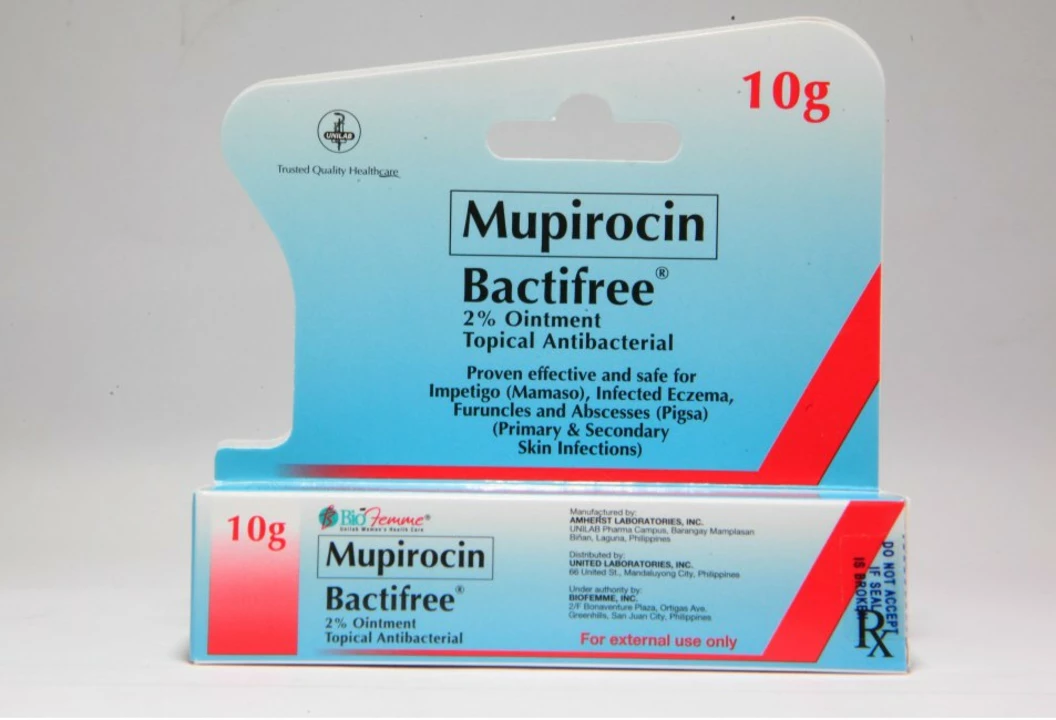The role of mupirocin in treating skin infections: what you need to know

Introduction to Mupirocin: An Overview
As a blogger who deals with various health topics, I often encounter questions about skin infections and their treatments. One of the most common medications prescribed for skin infections is mupirocin. In this article, I will discuss the role of mupirocin in treating skin infections and provide you with all the essential information you need to know. So, let's dive into the world of mupirocin and explore its various aspects.
Understanding Skin Infections and Their Causes
Before we delve into the specifics of mupirocin, it's crucial to have a basic understanding of skin infections and their causes. Skin infections can be caused by various microorganisms, such as bacteria, fungi, and viruses. The most common bacterial skin infection is impetigo, which affects millions of people worldwide. Other bacterial infections include cellulitis, folliculitis, and furunculosis. Fungal and viral infections also pose a significant threat to our skin health.
Several factors can increase the likelihood of developing a skin infection. These include poor hygiene, weakened immune system, skin injuries, and underlying medical conditions like diabetes. No matter the cause, it's essential to treat skin infections promptly to prevent complications and promote healing.
What is Mupirocin and How Does it Work?
Mupirocin, also known by the brand name Bactroban, is a topical antibiotic that is specifically designed to treat bacterial skin infections. It belongs to a class of medications called 'monoxycarbolic acids.' It works by inhibiting the growth and reproduction of bacteria, ultimately killing them and preventing the infection from spreading.
Mupirocin is effective against a wide range of bacteria, including Staphylococcus aureus, Streptococcus pyogenes, and other gram-positive bacteria. These are the most common culprits behind bacterial skin infections, making mupirocin an excellent choice for treatment.
Using Mupirocin: Proper Application and Dosage
It is essential to use mupirocin correctly to ensure its effectiveness in treating skin infections. Mupirocin comes in the form of a cream or ointment and is applied directly to the affected area. Before applying the medication, make sure to clean and dry the skin thoroughly. Then, using a cotton swab or your fingertip, apply a thin layer of mupirocin to the infected area.
The standard dosage for mupirocin varies depending on the severity and type of infection. In most cases, the medication should be applied two to three times daily for one to two weeks. However, it's crucial to follow your healthcare provider's instructions and complete the full course of treatment, even if the symptoms improve before the medication is finished.
Potential Side Effects and Precautions
Like any medication, mupirocin can cause side effects in some individuals. The most common side effects include itching, burning, and redness at the application site. These symptoms are generally mild and subside as the body adjusts to the medication. However, if the side effects persist or worsen, it's essential to consult your healthcare provider.
In rare cases, mupirocin can cause severe allergic reactions, such as difficulty breathing, hives, or swelling of the face, lips, tongue, or throat. If you experience any of these symptoms, seek immediate medical attention. Additionally, if you have a known allergy to mupirocin or any of its ingredients, inform your healthcare provider before using the medication.
When Mupirocin May Not Be the Best Option
Although mupirocin is effective against a wide range of bacteria, it is not suitable for all types of skin infections. For instance, mupirocin is not effective against fungal or viral infections. If your skin infection is caused by a fungus or virus, your healthcare provider may prescribe a different medication, such as an antifungal or antiviral cream.
Moreover, some bacteria have developed resistance to mupirocin, making the medication less effective in treating certain infections. In such cases, your healthcare provider may recommend an alternative antibiotic or a combination of medications to ensure successful treatment.
Conclusion: The Importance of Treating Skin Infections Promptly
In conclusion, mupirocin plays a crucial role in treating bacterial skin infections. Its effectiveness against common bacteria, ease of application, and relatively mild side effects make it a popular choice among healthcare providers. However, it's essential to remember that mupirocin may not be suitable for all types of skin infections, and using it correctly is crucial for successful treatment.
If you suspect a skin infection or are experiencing symptoms, consult your healthcare provider as soon as possible. Prompt treatment is key to preventing complications and promoting healing. Stay informed and take good care of your skin!





Comments
Holly Green
May 13, 2023 AT 16:28Mupirocin works well, but it shouldn’t be used when a simple wash will do.
Craig E
May 15, 2023 AT 10:08It’s fascinating how a simple topical ointment can wield such influence over bacterial ecosystems. The mechanism-blocking isoleucyl‑tRNA synthetase-offers a precise strike against gram‑positive culprits. Yet, the stewardship of this antibiotic demands a nuanced understanding of resistance patterns. Over‑application, especially in community settings, can inadvertently select for mupirocin‑resistant strains. While clinicians often prescribe it for impetigo, they must also consider the patient’s colonisation status. A thorough decolonisation protocol, perhaps combining chlorhexidine washes, can enhance outcomes. Moreover, the pharmacokinetics of this drug favor minimal systemic absorption, reducing systemic side‑effects. Nevertheless, vigilance is key; resistance surveillance should accompany each prescription. In sum, mupirocin remains a valuable tool when wielded responsibly.
Marrisa Moccasin
May 17, 2023 AT 03:48Surely you think it’s all sunshine and rainbows??? The pharma giants are secretly engineering resistant bugs!!! Every time we pop a cream they’re watching, they’re manipulating, they’re-
It’s not a coincidence that we’re urged to “use it as directed” while they stockpile data on our skin flora!!!
Caleb Clark
May 18, 2023 AT 21:28Look, I’ve tried every over‑the‑counter ointment you can think of, and I gotta say, mupirocin is the real deal – it actually clears up those nasty little red spots that keep coming back. I mean, sometimes I forget to put the cream on the right spot, but even then it works fast – like within three days you see a big difference! The only thing is you gotta keep at it, you know, two or three times a day, and don’t be that guy who quits when it looks better because you think you’re done. I read that it’s effective because it stops the bacteria from growing by blocking an essential enzyme, that’s why it’s so good on staph. Some people worry about side effects, but honestly I only felt a tiny itching at first,like a mosquito bite – nothing big. If you’ve got a small infection, give it a try, just follow the doc’s instructions, and you’ll be back to normal in no time!
Eileen Peck
May 20, 2023 AT 15:08Yep, you’re right – just make sure the skin is clean before you slap it on, and don’t skip the last dose.
Oliver Johnson
May 22, 2023 AT 08:48Our nation’s health depends on strong, proven treatments. Mupirocin is a home‑grown solution that keeps our kids off the streets with nasty infections. It’s a simple, effective drug, and we should support its use, not let foreign pharma dictate what we do.
Taylor Haven
May 24, 2023 AT 02:28While patriotism is admirable, the truth is that the pharmaceutical industry has been quietly pushing this ointment for decades, embedding it in every clinic’s standard protocol. The subtle pressure to prescribe it comes from a network of lenders, lobbyists and secret agreements. If we look closely, the rise in mupirocin‑resistant Staphylococcus is no accident, it’s a consequence of unchecked use. Some claim it’s safe, but the data reveals a pattern of allergic responses that are under‑reported. The government’s health agencies are complicit, rolling out guidelines that favour manufacturers’ interests. Remember, every time a doctor writes a prescription, a hidden fee slips into the system. By the time the resistant strains spread, it’s too late for the average patient. So stay vigilant, demand alternative therapies, and question the narratives fed to us by the establishment.
Sireesh Kumar
May 25, 2023 AT 20:08Okay, let’s break this down. Mupirocin is a top‑caliber antibiotic for skin infections, especially caused by Staph aureus. You apply a thin layer twice daily, usually for 5‑10 days – that’s the standard protocol. If you’re dealing with impetigo, it’s a first‑line choice because it’s cheap and effective. But don’t forget – it won’t work on fungal stuff, so a proper diagnosis is essential. Some clinics even combine it with chlorhexidine baths to curb colonisation. All in all, it’s a solid tool in the dermatologist’s kit, provided you respect the dosage and finish the course.
Jonathan Harmeling
May 27, 2023 AT 13:48Exactly, Sireesh – finishing the full course is key to avoiding resistance and ensuring the infection clears.
Ritik Chaurasia
May 29, 2023 AT 07:28From a global health perspective, mupirocin’s low cost makes it a vital resource in low‑income regions. Yet, we must balance access with stewardship to prevent the spread of resistant strains worldwide.
Gary Marks
May 31, 2023 AT 01:08Listen, the whole conversation about "global stewardship" sounds nice, but the reality is that big‑pharma is already pulling the strings, pumping out cheap ointments while hiding the long‑term data. You see the same pattern with other antibiotics – they push one drug, watch resistance develop, then promote the next. It’s a vicious cycle that leaves patients with fewer options. If we keep handing out the same cream without monitoring, we’ll end up with super‑bugs that no one can treat. So yeah, love the idea of access, but demand real transparency and better surveillance. Otherwise we’re just feeding the beast.
Vandermolen Willis
June 1, 2023 AT 18:48👍 Great points! Using it correctly really makes a difference. 😊
Mary Keenan
June 3, 2023 AT 12:28Short and sweet – just do what the label says.
Steven Young
June 5, 2023 AT 06:08The data clearly shows that misuse leads to resistance, and it’s up to clinicians to enforce proper guidelines. Overprescribing is a systemic issue that cannot be ignored. One must consider the broader epidemiological impact, not just individual outcomes.
Kelly Brammer
June 6, 2023 AT 23:48Indeed, guidelines exist for a reason; we must follow them.
Ben Collins
June 8, 2023 AT 17:28Oh, sure, because a tiny cream is the holy grail of modern medicine. Let’s all bow down to the almighty ointment while ignoring lifestyle factors.
Denver Bright
June 10, 2023 AT 11:08I guess it works for some people.
Kelli Benedik
June 12, 2023 AT 04:48Okay, let’s get dramatic about this! 🎭 Mupirocin isn’t just a cream, it’s a hero in a tiny tube, stepping onto the battlefield of my skin with swagger and style. ✨ Every time I spread it, it’s like sending in an elite SWAT team to bust those bacterial bad guys that have been throwing a constant rave on my forearm. 🙅♀️ The party stops, the lights dim, and my skin finally gets the peace it craves. 🌙 But, oh my gosh, sometimes the side‑effects pop up like unexpected plot twists – a little itch, a splash of redness, a tiny burning sensation that feels like a drama queen’s entrance. 😅 It’s a trade‑off, you know? You can’t have a blockbuster without a bit of suspense. 🕵️♀️ And let’s not forget the “resistance” saga – the villains evolving, trying to dodge the hero’s blows. That’s why we have to stick to the script, finish the full course, and not bail early just because the curtain seems to be falling. 🎬 Oh, and the prep? Clean, dry skin is the perfect stage. No weird oils, no leftover soap soap opera – just a clean canvas for our star. 🎨 And the dosage? Two‑three times a day, like clockwork, like a metronome ticking in a symphony. 🎶 The whole thing feels like a meticulously choreographed dance, a waltz of science and patience. 💃 So, to all my fellow skin‑warriors, trust the regimen, respect the hero, and keep those pesky microbes on the chopping block! 🗡️💥
cariletta jones
June 13, 2023 AT 22:28Love the enthusiasm! Consistency is key, and you’re spot on about the clean skin prep.